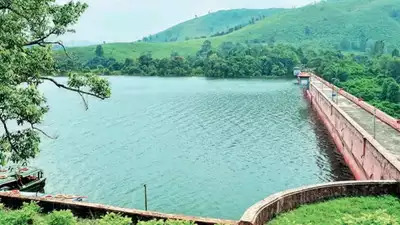In late 2021, the Supreme Court passed an order to continue the Mullaperiyar water consumption techniques employed to be feasible and to be continued on future basis. It allowed the Supervisory Committee to operate till the National Dam Safety Authority came into force but what was actually the case? Let’s delve into the subject and put our conscience to its best.

The Mullaperiyar dam has been an elixir for the farmers of Tamil Nadu but its maintenance cost and flooding issues have always perturbed the people of Kerala especially during the monsoon. The 126 year-old structure has benefited farmers in Tamil Nadu by diverting water to the state’s Dindigul area for agricultural reasons. It is constructed at the junction of the Mullayar and Periyar rivers. The dam is located in the Western Ghats’ Cardamom Hills. This dam has been making headlines for quite some time now. While this has been the topic of legal dispute between the two Southern governments and the United Nations, (UN) study claims that it is on the verge of collapsing, which might claim the lives of numerous people, surrounding around 0.1 million lives.
The catchment region and a large portion of the dam are located in Kerala’s Idukki district. In 1789, a minister called Pradani Muthirulappa Pillai proposed diverting Periyar’s westward flowing water into the Vaigai river which flows into the neighbouring state of Tamil Nadu. Captain J.L. Caldwell, a member of the ‘Madras Engineers’, popularly known as the ‘Madras Snappers’ , surveyed the dam’s location at the time. The Mullaperiyar Dam was ultimately permitted to be built in 1882 and after years of backbreaking endeavour, the dam got its base. Major John Pennycuick was the man behind the construction and he is still well-known in both the states today. On October 29 1886, the Maharaja of Travancore (Visakham Thirunal Rama Varma) and the Secretary of the State of British India signed a 999-year lease indenture. This was signed after the two sides negotiated for 24 years. There was the 1886 agreement signed between the Travancore princely state(now Kerala) and the British government to divert west flowing rivers to the east through a tunnel for irrigating about 58,650 hectares in the dry southern districts of Tamil Nadu. When India gained freedom in 1947, everything changed. Almost 10 years later, Kerala became a state and the pact was ruled null and invalid. The lease was finally extended in 1970 when C. Achutha Menon was Kerala’s Chief Minister. For many years, Tamil Nadu has been paying the Kerala government a tax of 2.5 lakhs per year for the use of the land as well as a surcharge of 7.5 lakhs for the power produced. The deal is still being contested between the two states and remains a bone of contention.
The construction of the dam began in 1887. The dam was constructed using limestone and a burnt brick powder called ‘Surkhi’. Pennycuick’s main issue was the river’s diversion. Because of the repeated rains and floods, the temporary embankments built to control the flow of water were demolished. Because of this issue, British officials halted the dam’s funding. Though the construction did not stop, Major Pennycuick then sold his wife’s jewellery to fund the dam’s construction. It forms a reservoir in the Periyar river’s canyon through which the water flows westward. It eventually drains into a ravine on the Vaigai river in Tamil Nadu travelling through Dindigul, Theni, Madurai and Sivaganga districts. Major Pennycuick is still renowned for his efforts at building the dam. His statue is now on display at the state PWD office in Madurai. His great-grandson was honoured in the city in 2002 and the event drew thousands of people who were eager to see him.
While the Mullaperiyar dam is historically significant in both states, its structural foundations are highly dubious. According to the United Nations research vertical, the United Nations University has raised an alarm about the dam’s location being in a ‘seismically active area’ which would be extremely harmful to the people living nearby. The ageing of large dams is a major source of concern. In July 2011, residents of the state’s Idukki district felt several tremors. While they were not life-threatening, their impact was felt when the dam’s water level rose to 136 feet. This is thought to be greater than its actual capacity. The consumption capacity of Tamil Nadu demands 142 ft but the Kerala government cannot offer more than 138 ft because of life threats causing a major wrangle between the two states.
Every issue has an impact, some of which are obvious while others are not. The same can be said for the Mullaperiyar dam legislation passed by the Supreme Court. Recently, the Supreme Court issued legislation against the Kerala government in light of the potential repercussions that people may face due to water shortage in Tamil Nadu. Though the choice appears to have affected the lives of the local people, yet the taxation system will continue to exist as Tamil Nadu used to pay to utilise the water. Proper techniques, such as timely checking and monitoring the water level of the dam, can be advantageous to both the states.

Sanjay Yadav
Sanjay Yadav is a MBA-RD professional by education. He has completed his education in Bachelor of science with PCM from Ewing Christian College(AU. He is an avid reader and loves to play online games in his free time.


I have not checked in here for a while since I thought it was getting boring, but the last several posts are great quality so I guess I¦ll add you back to my everyday bloglist. You deserve it my friend 🙂
Excellent read, I just passed this onto a friend who was doing some research on that. And he actually bought me lunch because I found it for him smile Thus let me rephrase that: Thanks for lunch!